

Thermoforming technique is a modern manufacturing technology that is versatile, cost-effective, and efficient. Its design flexibility and quick production cycles make it an apt choice for both prototyping and high-volume production.
The thermoforming technique provides manufacturers a wide range of solutions via the processing of plastic sheets. In this article, we discuss in detail the various thermoforming processes, materials that can be processed via thermoforming, equipment, and design considerations.
Thermoforming is a type of manufacturing process that specifically includes heating plastic sheets and molding them as per the required designs. When the plastic sheets are shaped into the required design, they are cooled down and then trimmed to create the finished part.
Thermoforming is a highly versatile manufacturing process that involves transforming thermoplastic sheets into an array of products that can have varying shapes and complexities. This technique can be applied to manufacture simple products such as plastic containers to more complex and intricate automotive parts.
This entire process is executed in a thermoforming machine in which the plastic sheet is heated, stretched over the mold, and further trimmed. Most modern thermoforming machines are equipped to handle the cutting process whereas in most conventional machines, the cooling and trimming is carried out externally. This technique enables businesses to manufacture plastic parts quickly and cost-effectively.
There are various types of thermoforming processes. In this section, we discuss the most popular thermoforming technique:
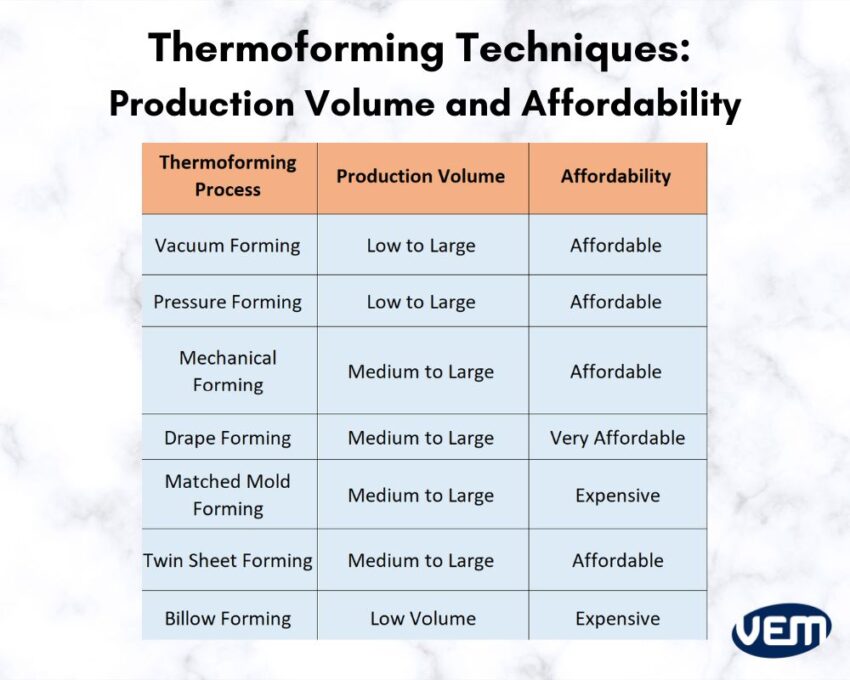
The vacuum forming process, when compared to other techniques, is faster and cost-effective. This technique makes use of a vacuum to shape the plastic sheet. In this case, the plastic sheet is heated to make it flexible, after which, the vacuum-forming machine pulls the air out, which forces the sheet against a mold.
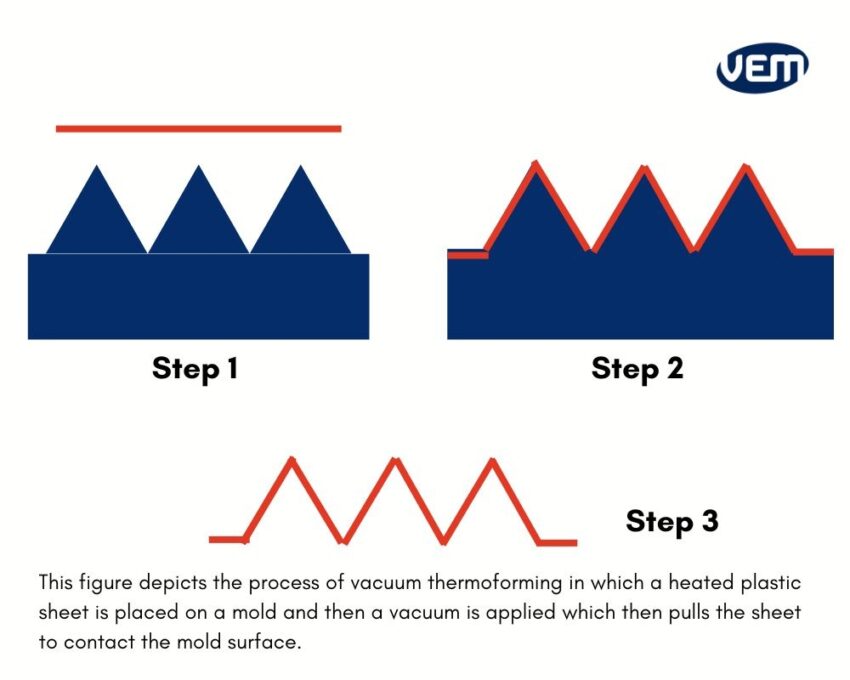
This process involves creating the part from a single mold which means less tooling requirement. However; there may be instances when the wall thickness may not be uniform as the heated plastic hits the mold top first and then immediately starts to cool off which can lead to the formation of thicker mountains and thinner valleys.
Pressure pressure-forming technique is applied when the design details are more intricate. The pressure forming technique is similar to the forming process, where the plastic sheet is heated and a vacuum is utilized to pull the air away so that the sheet can be forced against the mold. Once the air is removed, a pressing tool applies pressure to ensure that the part maintains its shape better.
In this type of thermoforming, the heated plastic sheet is shaped by a direct mechanical force. This technique is applied for highly detailed, intricate, and precise parts.
In mechanical forming, a core plug forces the plastic sheet and this force helps to fill the space between the plug and the mold which further imprints the surface patterns on the heated plastic sheet.
Drape forming is one of the most affordable techniques among most thermoforming techniques as minimum tooling is required.
Drape forming makes use of a mandrel which is a cylindrical tapered rod that is designed according to the specific pattern. In this technique, the heated plastic sheet is pressed on the patterned mandrel to form the finished part.
The major advantage of this technique is that this particular process maintains material thickness thus, avoiding weaknesses in parts.
Matched-die thermoforming technique is applied when higher levels of precision and accuracy are required. This technique further enables uniform wall thickness. However; this technique requires more tooling and machinery than other thermoforming techniques.
In this thermoforming technique, two molds are used to apply pressure to the heated plastic sheet. One mold is on the top and one mold is on the bottom and the plastic sheet is placed between these two molds. Now, when the molds press together upon the heated plastic sheet, they create the required pattern for the part.
The Billow forming technique is a free-form technique as it does not incorporate molds to shape the heated plastic sheet. In this technique, the forming machine makes use of air jets to blast the heated plastic sheet into a bubble and this continues until the final design is created.
In this thermoforming technique, two layers are joined together to form one single part. In this technique, the plastic sheets are heated, molded, and joined with each other. This technique is generally applied to manufacture hollow parts that have two walls.
Each thermoforming process requires specialized equipment and thus, thermoforming equipment is further categorized primarily based on their use cases. Let’s understand various types of thermoforming equipment further:
Industrial thermoforming equipment is a large-scale machine that is built for mid-to large-volume production.
These machines are typically compatible with a wide range of materials and can process plastic sheets of various thicknesses. In addition, they offer a deeper draw and have stronger vacuum forces which helps to create and form complex and intricate details. Industrial thermoforming equipment may cost between 10,000$ and 100,000$.
Desktop thermoforming equipment is typically used for manufacturing prototyping, custom parts, and low-volume production.
This type of thermoforming equipment has reduced dimensions and applies lower forces. It supports a wide range of materials and the cost is within the range of 1,000$ to 10,000$.
DIY thermoforming equipment is typically used either by hobbyists or enthusiasts or for extremely low-volume production runs. It’s relatively affordable but is more labor-intensive and requires expertise.
Let’s understand various materials that can be used to manufacture plastic parts via thermoforming techniques.
Polypropylene is one of the most popular thermoforming plastics and is commonly applied due to its innate properties and excellent resistance to chemicals, fatigue, and heat.
Polypropylene is a cost-effective material that can be applied to a variety of thermoforming processes.
Polystyrene is an aromatic hydrocarbon that’s transparent and brittle. It’s widely used as a packaging material as it is extremely resistant to air and water.
Polyethylene terephthalate is commonly used to manufacture bottles of carbonated beverages and water bottles. It demonstrates great tensile strength and excellent chemical and impact resistance.
LDPE is a lightweight thermoplastic that demonstrates excellent resistance to chemicals and UV rays. It’s also flexible and has a high tensile strength. LDPE is primarily used to manufacture packaging films and containers.
HDPE, similar to LDPE, is also resistant to chemicals, water, and UV rays. HDPE is often used to manufacture packaging films, plastic bags, containers, and pipes.
PVC can either be flexible or rigid and is used for manufacturing an array of products such as pipes, automotive interiors, consumer goods and packaging products. PVC is durable, and resistant to water.
Polycarbonates are tough plastics that can undergo deformations without cracking. They are extremely heat-resistant, and demonstrate good electrical insulator properties.
PMMA demonstrates high strength, durability, and transparency. It is often applied to manufacture lenses, headlamps for vehicles, and transparent packaging.
ABS is rigid and demonstrates resistance to abrasion and low temperatures. ABS is often applied to manufacture electronic packaging, and food containers via thermoforming. , and domestic appliances.
Thermoforms and thermosets are two sets of plastics but in the case of thermoforming techniques, typically thermoforming plastics are applied. Let’s understand the key difference between these two sets of plastics.
Thermosetting plastics are extremely rigid and highly resistant to heat. Thus, they are primarily used in applications where there will be extensive exposure to heat. You should note that once thermosets are melted, they cannot be melted again. Some examples of thermosetting plastics are Epoxy resin, Melamine, and phenol-formaldehyde.
Thermoforming plastics are more brittle and malleable. They can also be reheated such that they form into varying shapes repeatedly. Since thermoplastics can be trimmed, remodeled, and recycled, they are apt for thermoforming techniques. Some examples of thermoforming plastics are polypropylene, polyvinyl chloride, nylon, and polythene.
Thermoforming technique, just like other manufacturing processes, has various stages of thermoforming.
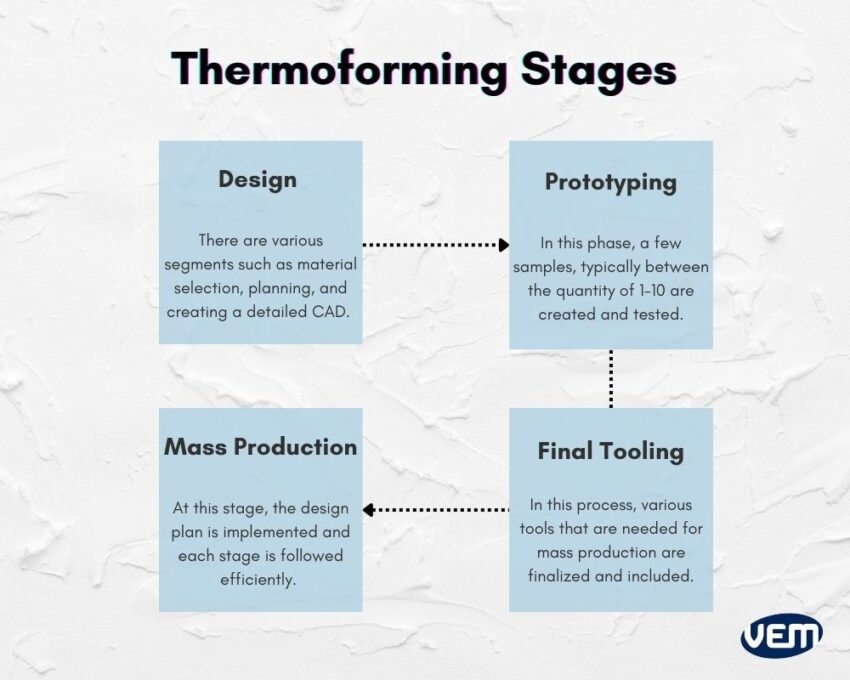
Let’s understand these stages further:
The first stage is the design stage and in this stage, there are various segments such as material selection, planning, and creating a detailed CAD. The design stage enlists every detail of the project.
The next phase is prototyping. Once the design stage is complete, the next phase is testing and ensuring design reliability.
In this phase, a few samples, typically between the quantity of 1-10 are created and tested. If they are functionally and aesthetically as per the design, then you can move on to the next stage which is tooling. However; if the parameters are not as expected, then the design stage will need to be revisited.
In this process, various tools that are needed for mass production are finalized and included. For instance: Plastic materials, molds, and forming machines.
In this stage, production is carried out which is easier and faster than prototyping. At this stage, the design plan is implemented and each stage is followed efficiently.
Let’s further understand 2 more concepts of thermoforming technique i.e. thin gauge versus thick gauge.
Thin-gauge technique makes use of thin plastic sheets and is typically designed for high-volume production whereas thick gauge thermoforming makes use of thick plastic sheets and is designed for low to mid-volume production.
The dimensional difference between the plastic sheets is the differentiation factor between the 2 techniques and it plays a crucial role in selecting thermoforming equipment.
Thin gauge thermoforming techniques are specifically used to manufacture thinner items such as plastic cups and food packaging and thick gauge technique is applied to manufacture thick gauge equipment such as pallets, shower trays and containers. The following table indicates the key differentiating factors of the thin and thick gauge thermoforming techniques:
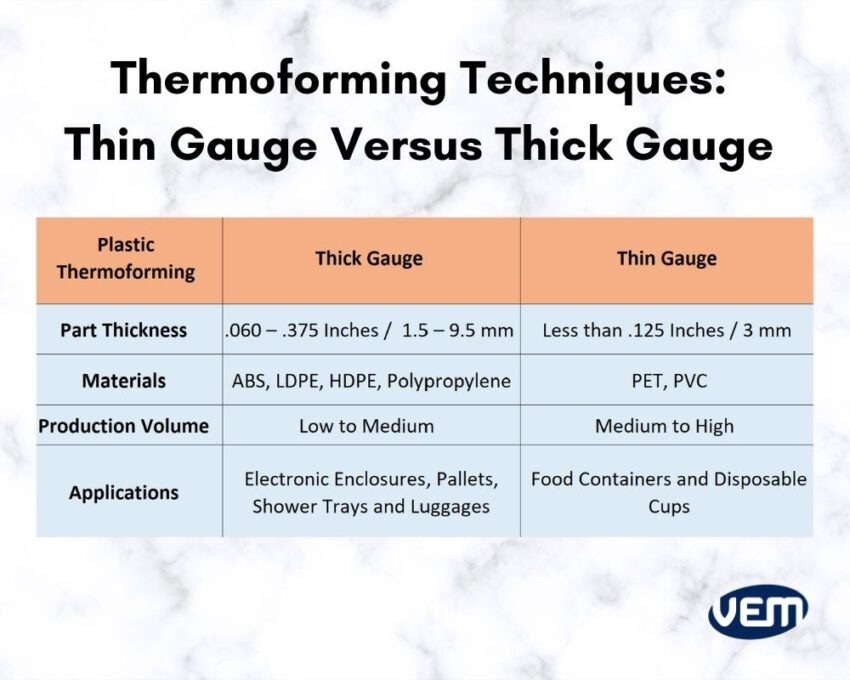
The mold in thermoforming tooling is typically single-sided. In this technique, the plastic sheet is heated such that it is flexible, and then clamped to the tooling.
Thermoforming tooling can be either male or female. A male tool is convex which means that the shape protrudes higher than the clamps whereas the female tool is concave, and in this case, the plastic is pulled inside the mold.
You should note that male tooling is relatively cheaper than the female tooling however; the female tool does allow for the creation of more complex shapes or parts with sharper corners.
The thermoforming technique is dependent upon various factors. In this section, we take a look at these considerations to help you manufacture parts accurately and precisely via thermoforming techniques.
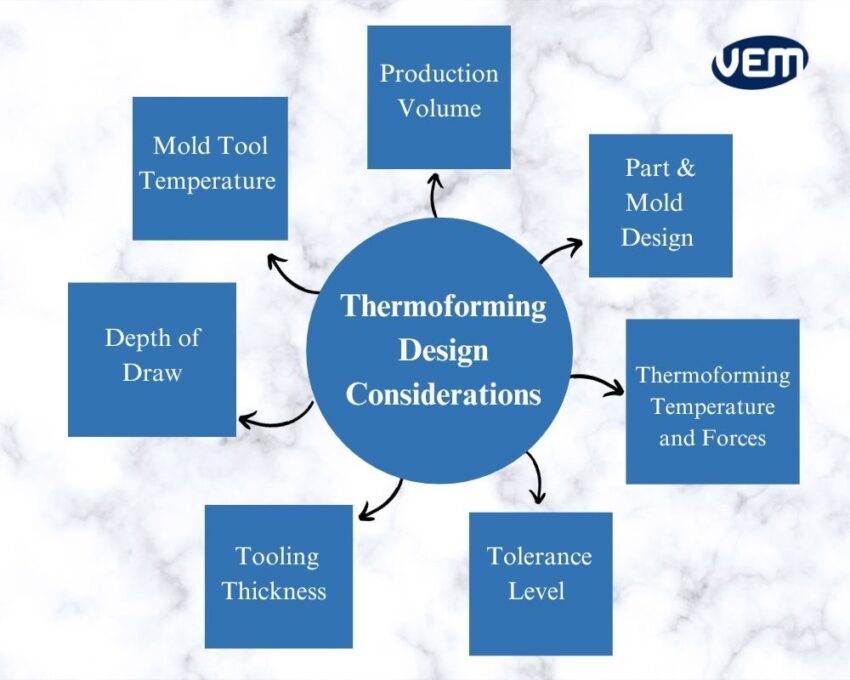
Production volume helps to finalize the mold type. Plastic and composite molds may be cost-effective but they are only suitable for low-volume production runs. If the production run is of high volume, then the metal molds are more apt as they have better thermal strength and conductivity. It also helps to achieve better control of the mold surface temperature, greater part-to-part uniformity, and better durability.
Part complexity is the next factor that must be considered as it plays a crucial role in determining the success of creating parts via the thermoforming technique! If the design is complex or accuracy and precision are a top requirement, then it’s better to include 3D printing and machining.
The mold should be designed such that it facilitates the thermoforming process. It must include features such as strategically placed openings for vacuum and extra ventilation areas so that the air can circulate from the forming process and draft corners. This exceptionally helps during part demolding. In addition, you must also consider various part quality standards such as the surface finish, and dimensional accuracy.
The thermal resistance of the mold is determined by the material type. The cooling rates can be enhanced by adding cooling channels to the mold which further improves the uniformity and decreases the production cycle time.
In addition, the tool must be structured such that it can endure extreme pressure and mechanical and vacuum forces.
The tolerance level depends upon the material type. You should note that the typical tolerance of part-to-part forming is +/- .025.
Tooling thickness depends upon the part type being manufactured. If heavy parts are being manufactured, then the tooling must be very thick.
The depth of draw, also known as draw ratio, is indicative of the required plastic gauge which further helps the manufacturers to determine the plastic part thickness.
A consistent quality can be maintained when the mold tool temperature is regulated. In most applications, coils are placed within the mold so that hot or cold water can circulate which helps to maintain the required temperature of the mold.
When compared to various manufacturing technologies, Thermoforming is one of the most cost-effective technologies for manufacturing plastic parts.
The tooling and equipment costs are generally lower with this technique thus, making it accessible to a wide range of industries.
The thermoforming technique enables efficient production of small volumes and prototypes. The designs can be tested very quickly when a thermoforming technique is combined with 3D-printed molds.
Various materials can be used to manufacture plastic parts via Thermoforming techniques. This variety enables the manufacturers to make material choices as per the desired properties such as transparency, rigidity, temperature range, chemical resistance, etc.
Thermoforming technique enables manufacturing of simple as well as intricate and complex designs. This technique replicates smooth curves and sharp angles accurately.
One of the major advantages of the thermoforming technique is that it relatively has shorter production cycles so it helps to meet tight deadlines.
The thermoforming technique produces an excellent surface finish. In addition, there are no parting lines thus, making it distinct from other plastic manufacturing technologies. In addition, thin films can be achieved via several materials.
Thermoforming is a sustainable choice as many thermoplastics that are primarily used for this technique can be recycled.
Though the thermoforming technique has various advantages, there are some challenges as well. Let’s understand these challenges further:
Thermoforming techniques can be applied to manufacture simple to complex parts of varying industries. The technique implementation depends upon the design characteristics and the use cases of the products. If you are unsure whether your product is suited for thermoforming or injection molding, don’t hesitate to contact us. Injection molding and tooling have been one of our core competencies for decades.
At VEM-Tooling, we have an experienced team of design experts and engineers to help you choose the right solution for your project!